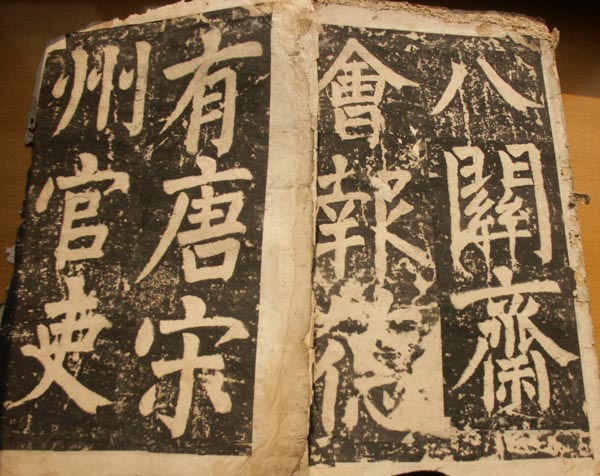In the sixth year of Tianbao in the Northern Qi Dynasty (AD 555), Li Qing, a native of Junxiang County, Bingzhou Township (today's east of Wuxiang County, Shanxi Province), was passing through Shimenkou, Pingding County, Shanxi Province. In order to repay the kindness of Li Xian and Li Xizong's father and son, he rubbed the cliff by the roadside. He carved a tablet to describe his aspirations. The head of the stele: "The two father-in-law and his son treated Qing with courtesy, and were invited by the court, and Qing was virtuous. The old virtuous man was not punished by having his neck cut off. He went home for five hundred miles, and then went to Xingye, Guanyu, and the garrison. It was a long distance of thousands of miles, and Baizhou Road On the side, a stele is built to repay virtue, and it is carved on a rock to be immortal." This is the origin of the stele.
Li Xian and Li Xizong died in the third year of Xiaochang (526) in the Northern Wei Dynasty and the second year of Xinghe (540) in the Eastern Wei Dynasty respectively. After a lapse of several years, Li Qing did not miss his old kindness, but he was here to dig into the rocks and truly see the friendship between them. In 1975, Li's tombs were discovered in the southeast of Nanxingguo Village, Zanhuang County, Hebei Province. This Li family cemetery is a family cemetery of the Li family in Zhaojun during the Northern Dynasties. The five tombs distributed here are from west to east. The first one is Li Xian's second son, Li Xizong, the Sikong of the Eastern Wei Dynasty, and his wife Cui. The tomb of Li Xian, the third son of Li Xian, the prince of the Eastern Wei Dynasty, and the minister of Huangmen, Li Xiren, is ranked first. The second place is; Li Xian's fourth son, Li Chun, the minister of Huangmen in the Eastern Wei Dynasty, is third; Li Xian's fifth son, Li Xili, the governor of Manchuria in the Northern Qi Dynasty, is fourth; the one in the northern row is the hussar general of the Northern Wei Dynasty. The tomb of Li Xian, the governor of Dingzhou.
At the same time, Li Xizong's epitaph was discovered, proving that Li Xizong's tomb was erected on November 9, the second year of Wuding in the Eastern Wei Dynasty (544). The epitaph is made of stone and is in one piece. The cover is of the Zhending style, with the seal "Wei Zhi" engraved in the middle, with 3 lines and 9 characters. The Zhi stone is 0.62 meters long and 0.62 meters wide. The first title is: "On the 11th day of the 11th month of the 11th year of the reign of Emperor Wu of the Great Wei Dynasty, Li Jun "Tombstone". The epigraph has 30 lines, 30 characters, and 817 characters in total. There are grids between characters. The font is Wei stele style. The inscription is: Li Xizong (501-540), courtesy name Jingyuan, the second son of Li Xian, the successor Brother. Xizong started as a Taiwei and joined the military. Later, he became a doctor in Daxingtai, King Xianwu of Qi. He became an official in the Eastern Wei Dynasty and became the director of the Chinese and Foreign Affairs Bureau. He won the trust of Gao Huan and was an important counselor of Gao Huan's group. In the second year of Xinghe (540) ) died in April (Book of Wei, Volume 36, Biography of Li Shun), at the age of 40. He was given the imperial edict to the envoy Chijie, the governor-general of the military affairs of the five states of Hebei, Cang and Yin, the general of Hussar, the governor of Yinzhou, and Sikong Gong. His posthumous title was Wen Jian.
He was buried on November 9th, the second year of Wuding (544). The biography of Li Shun in "Book of Wei" and "History of the North" is followed by a biography of Li Xizong, which is consistent with the content of the epitaph. According to records in the "Book of the Northern Qi Dynasty", Queen Gaoyang "is the daughter of Li Xizong of Zhao County". "Book of Wei: Biography of Li Shun" also records that "King Qi (Gao Yang) accepted his second daughter". It can be seen that Li Xizong was not only "acclaimed as a minister of the country, with hope of cooperation and assistance", he was Gao Huan's cousin and had a very close relationship with the ruling group.
"Li Qing Bao De Monument" is a statue monument. Statue stele is an ancient Chinese stele that mainly carves Buddha statues. There are niches for statues on the stele, usually including Buddhist statues and Taoist statues. The reason for the statue and the name, place of birth, and official position of the statue are engraved on the stele. There are also lined figures of the donors. Statue steles were popular in the Northern Dynasties, with the majority of them from the Eastern Wei - Northern Qi and Western Wei - Northern Zhou dynasties. They are mostly found in Henan, Shaanxi, Shanxi, Gansu and other provinces. As the Sui and Tang Dynasties declined, the characteristics of their sculpture themes and styles were generally close to those of the cave temple art of the same period. Because they were carved on stele stones, they were mostly relief sculptures. They were important physical materials for studying religious art and religious history at that time. In view of this, the "Li Qing Baode Statue Stele" at Changguo Temple in our county is worthy of our preservation and study.









